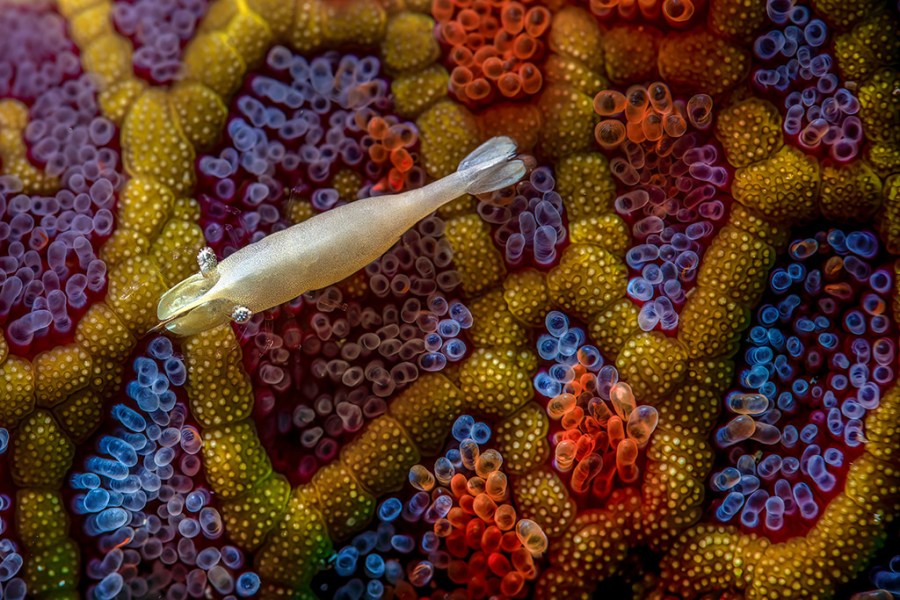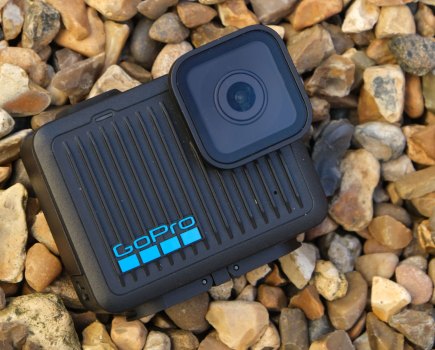Winners of the fifth Close-up Photographer of the Year competition have been announced! Congratulations to Csaba Daróczi who has taken home the title prize with his creative image The Bird of the Forest. Entrants to Close-up Photographer of the Year 5, supported by Affinity Photo 2, share the stories and techniques behind their close-up and macro pictures with competition co-founder Tracy Calder below.
Apparently, Leonardo da Vinci used to get up every morning and write a list of all the things he wanted to learn that day. You’ve got to admire his drive, and the fact that he died at the ripe old age of 67 (life expectancy was around 35 back then) seems to suggest that his thirst for knowledge might have played a part in keeping him alive. While I share none of da Vinci’s polymath brilliance, I do share his desire to learn something new every day. Imagine my delight, then, when I had the joy of spending more than 20 hours chatting to a group of brilliant scientists, naturalists, journalists, writers and photographers while judging Close-up Photographer of the Year 5 (2023)!
Thanks to these wonderful individuals I now know that tadpoles can eat birds, ants fire acid like water pistols and bees sometimes hold each other’s legs while they sleep. And then, of course, there is the knowledge gained from looking at the photographs and accompanying captions sent in. More than 11,000 creative and original pictures made by people whose passion and dedication to the craft of photography is abundantly clear. Personally, I think this is our best survey of close-up, macro and micro photography yet, and I’m so grateful to those who have provided the opportunity to see and learn from their work. I hope you feel the same.
This year there were 11 categories: Animals, Insects, Butterflies & Dragonflies, Invertebrate Portrait, Underwater, Plants, Fungi & Slime Moulds, Intimate Landscape, Human Made, Micro and Young CUPOTY. Csaba Daróczi took the overall title with his incredible image of a bird taken from inside a tree stump, while Carlos Pérez Naval was named Young Close-up Photographer of the Year 5 for his unusual picture of a Moorish gecko in a ‘petrified forest’.
To see the winners and Top 100 pictures from CUPOTY 5, visit www.cupoty.com. To stay up to date with all things CUPOTY sign up to the newsletter.


Close-up Photographer of the Year 5 Winners
Overall Close-up Photographer of the Year 5 Winner (and winner of the Animals) category
The Bird of the Forest by Csaba Daróczi

Camera: GoPro HERO11 Lens: 15mm ISO: 800 Aperture: f/2.5 Shutter speed: 1/5400sec Accessories: Remote control. Image: © Csaba Daróczi | cupoty.com
Category: Animals
Nationality: Hungarian
Occupation: Photographer
Further information: www.daroczicsaba.hu, Instagram: @daroczics
‘In the winter of 2023, I took a lot of photographs in a forest close to my home in Hungary. I found something new to photograph almost every week, and I spent several days exploring ideas and perfecting techniques. Staying curious and open-minded led me to this hollowed out tree stump, which measured around half a metre in diameter. I carefully positioned my GoPro 11 camera inside the trunk and took a few shots. I was amazed by the results. After a few days, however, I decided the composition might be improved if I included an animal in the frame. So, I returned to the spot and placed a sunflower near the hole, which the mice and birds soon found.’
Csaba’s top close-up photography tips:
- The GoPro is great for experimental shots such as this one because it offers generous depth of field, even at such a wide aperture.
- To make the most of opportunities as they arise, get to know your equipment – that way you can act quickly and intuitively.
- When you closely observe the behaviour of animals you can use this knowledge to help improve your pictures.
Winner: Fungi & Slime Moulds
The Ice Crown by Barry Webb

Camera: Olympus OM-D E-M1 Mk II Lens: Olympus M.Zuiko Digital ED 60mm f/2.8 Macro ISO: 200 Aperture: f/4 Shutter speed: 1/2sec Accessories: Tripod, cable release, three extension tubes, Raynox 250 Post processing: 74 images stacked in Zerene Stacker. Basic adjustments in Lightroom and Photoshop. Topaz DeNoise. © Barry Webb | cupoty.com
Category: Fungi & Slime Moulds
Nationality: British
Occupation: Gardener/photographer
Further information: Website: www.barrywebbimages.co.uk, Instagram: @barrywebbimages
‘I found this one-millimetre-tall slime mould (Didymium squamulosum) in leaf litter carpeting a woodland floor in Buckinghamshire. It was a cold January day, and the frost had formed a crown shape on top of the fruiting body. I had to be very careful not to breathe on it. During a previous attempt with another slime mould, my breath had melted the ice when I inadvertently got too close.’
Barry’s top close-up photography tips:
- Be careful not to breathe on frosty or icy subjects!
- Frosty mornings can create unique images, so wrap up warm and don’t be put off by inclement weather.
- Always be on the lookout for the unusual. I use a loupe to fully explore the possibilities presented by tiny subjects such as this.
Winner: Insects
Wood Ants Firing Acid Secretion by René Krekels
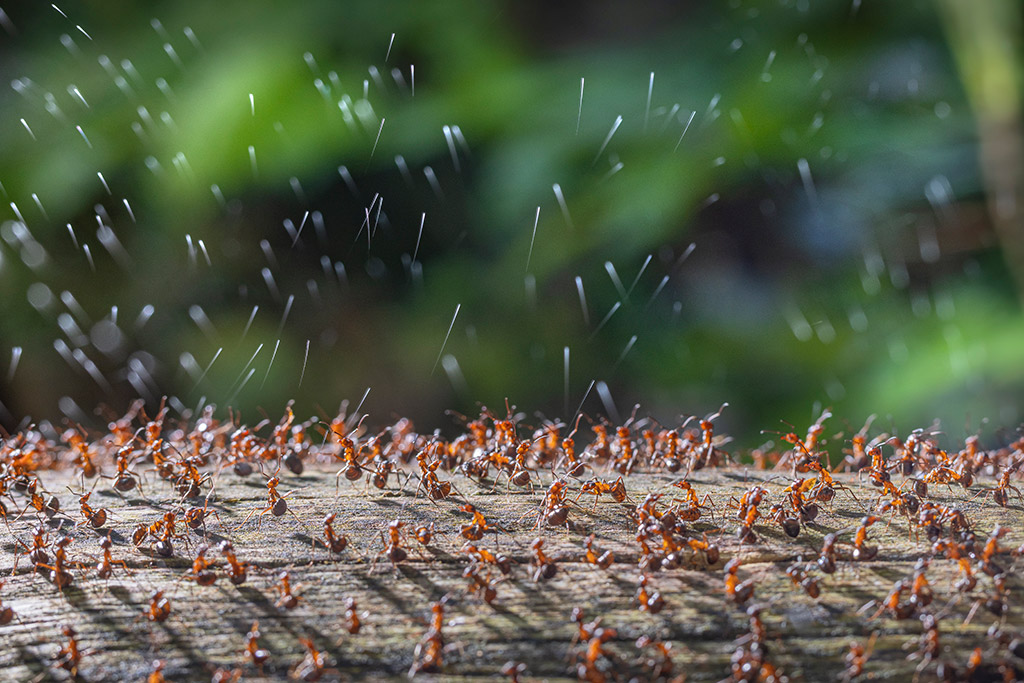
Camera: Canon EOS R5 Lens: Canon EF 100mm f/2.8 Macro IS USM ISO: 320 Aperture: f/9 Shutter speed: 1/125sec Accessories: Tripod and flashlights. © René Krekels | cupoty.com
Category: Insects
Nationality: Dutch
Occupation: Biologist
Further information: Website: www.renekrekels.nl, Facebook: rene.krekels
‘I had been studying the lifestyle of wood ants in the Netherlands for work when I noticed the defending ants of a very large ant’s nest seemed eager to scare me off by spraying acid towards me. Luckily it wasn’t that destructive, and it provided me with a great opportunity to photograph them defending the nest.’
René’s top close-up photography tips:
- Know your subject and its ecology, so you can anticipate its behaviour.
- Be sure that your trousers are not easy to climb up or you’ll get a tickling bite in your belly or arms from the ascending ants.
- Come back during different seasons to see different behaviour.
Winner: Butterflies & Dragonflies
The Wedding Guest by Csaba Daróczi

Camera: Nikon Z6 Lens: Nikkor AF-S 24mm f/1.4G ED ISO: 3200 Aperture: f/1.4 Shutter speed: 1/320sec Accessories: None. © Csaba Daróczi | cupoty.com
Category: Fungi & Slime Moulds
Nationality: Hungarian
Occupation: Photographer
Further information: www.daroczicsaba.hu, Instagram: @daroczics
‘I was photographing a wedding in a forest clearing in the beautiful surroundings of Uzsa, Hungary. The hall lights attracted a lot of insects to rest on the windows. At one point, I saw some guests taking pictures with their phones next to one of the red lights. As I moved closer, I noticed an oak peacock moth (Antheraea yamamai) had taken up residence on the window. I waited until everyone had finished their pictures, and then it was my turn.’
Csaba’s top close-up photography tips:
- Light can be used to attract animals, be ready to seize any opportunity.
- Take advantage of good fortune – stay open-minded and ready for action.
- Try and tell a story with your picture – understanding the behaviour of the butterfly certainly helped here.
Winner: Invertebrate Portrait
Jumping Stick by Tibor Molnar
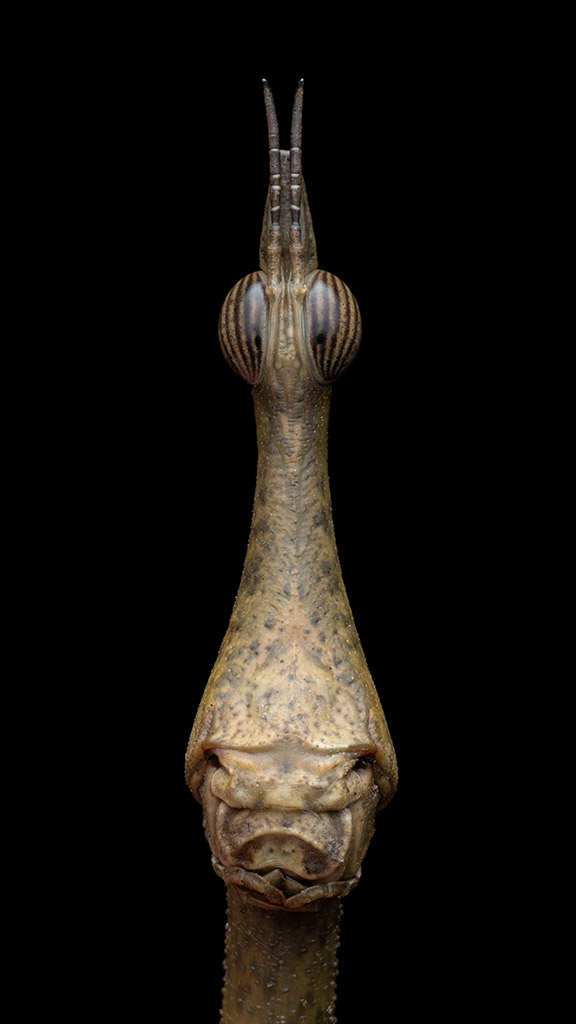
Camera: Olympus OM-D E-M1 Mk II Lens: Olympus M.Zuiko 60mm f/2.8 Macro ISO: 100
Aperture: f/5.6 Shutter speed: 1/50sec Accessories: Godox V350o flash with Cygnustech diffuser Post processing: Seven frames stacked in Helicon Focus, Topaz DeNoise. © Tibor Molnar | cupoty.com
Category: Invertebrate Portrait
Nationality: American
Occupation: IT Manager
Further information: Instagram: @thetibormolnar
‘When we travelled to Ecuador, I knew there would be an opportunity to see jumping sticks in the Amazon region. When we found the first of several creatures, I was beyond excited. I had imagined this shot in my mind for a long time and it was incredible to actually have this opportunity to make it happen. The best way to describe these invertebrates is part walking stick part grasshopper! When they jump, they are not particularly graceful, and they tend to tumble around completely off-balance.’
Tibor’s top close-up photography tips:
- Do your research ahead of time. If you know you will be visiting a particular area, learn what to expect there.
- Using a flash and diffuser will help you to record all of the striking details.
- Focus stacking will enable you to get more of the subject sharp.
Winner: Human Made
Asymmetrical Threads by Elizabeth Kazda
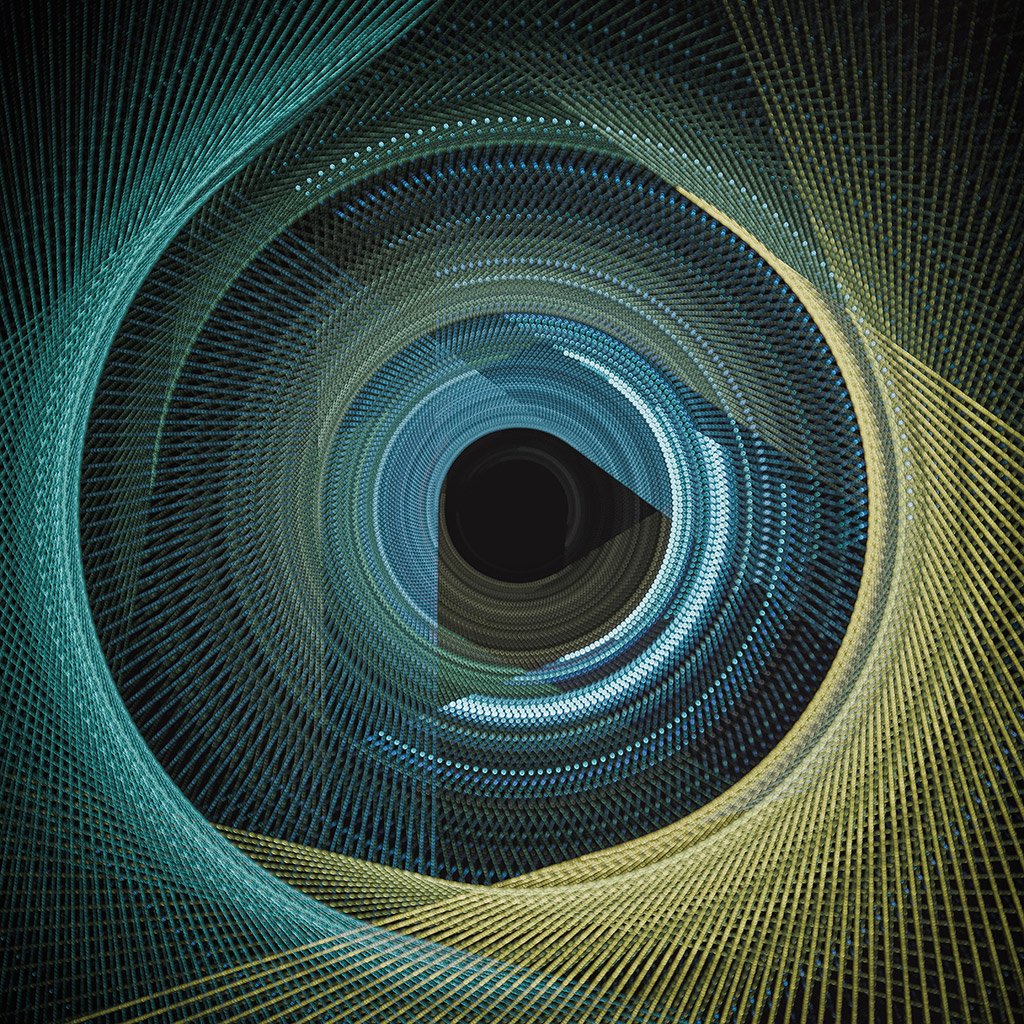
Camera: Nikon D850. Lens: Nikkor 24-85mm. ISO: 64. Aperture: f/4.5. Shutter speed: 1/5sec
Accessories: Tripod, remote shutter release, ring light, motorised rotating platform. © Elizabeth Kazda | cupoty.com
Category: Human Made
Nationality: American
Occupation: Artist
Further information: Website: elizabethkazda.myportfolio.com, Instagram: @elizabethkazda, Facebook: beth.kazda
‘I enjoy pushing the limits of my camera’s capabilities and experimenting with new techniques to capture ordinary objects. My collection of art supplies includes numerous spools of coloured thread from previous projects. I wanted to photograph this thread in a unique way and came up with the idea of wrapping coloured strands around an open picture frame. I placed the frame on a motorised rotating platform and set my camera to multiple-exposure mode. I captured 64 photos of the thread at 64 equidistant positions as I rotated the platform. Since I didn’t complete a 360° rotation, the design is asymmetrical. This is a meticulous process that requires patience. For this image, I used an in-camera multiple exposure of 64 frames to output a single Raw file.’
Elizabeth’s top close-up photography tips:
- Photograph everyday objects in unexpected ways. Try varying the lighting to change the composition.
- Experiment with the camera’s multiple exposure mode.
- Learn to work in manual mode for the most creative options.
Winner: Micro
Beach Grass by Gerhard Vlcek

Camera: Nikon Z6 II Lens: Olympus SPlan Apo 10/0.40 microscope objective ISO: 100. Shutter speed: 1/3sec Accessories: Olympus BH-2 microscope
Post processing: Panorama of two pictures stitched together in Lightroom and cropped in the centre to reveal the interesting structures. Basic adjustments in Photoshop. © Gerhard Vlcek | cupoty.com
Category: Micro
Nationality: Austrian
Occupation: Senior project manager
Further information: Website: www.foto-vision.at, Instagram: @gerhardvlcek, Facebook: FotoVisionat
‘This image shows a 30μm cross-section of beach grass (Ammophila arenaria) stained with Auramin O and Safranin and viewed under fluorescence blue excitation. The grass came from a friend’s garden in Vienna. For the best results I had to slice the sample as thinly as possible. First, I fixed some stems in warm liquid polyethylene glycol. As it cools down, it turns solid, and the embedded stems were placed in a microtome and sliced with a sharp blade. Staining and preparing the sample was very tricky. I had to use the tiniest brush to manipulate the less than 1mm parts in different staining and chemical solutions before positioning the stems on the slide. After that, taking the photograph was the easy part!’
Gerhard’s top close-up photography tips:
- Find interesting plant structures and use a microtome (cutting tool) to prepare very thin cuts for a sample.
- Use fluorescent dyes for staining.
- The better the sample the less time you’ll have to spend in post-production.
Winner: Intimate Landscape
Undertow by Csaba Daróczi
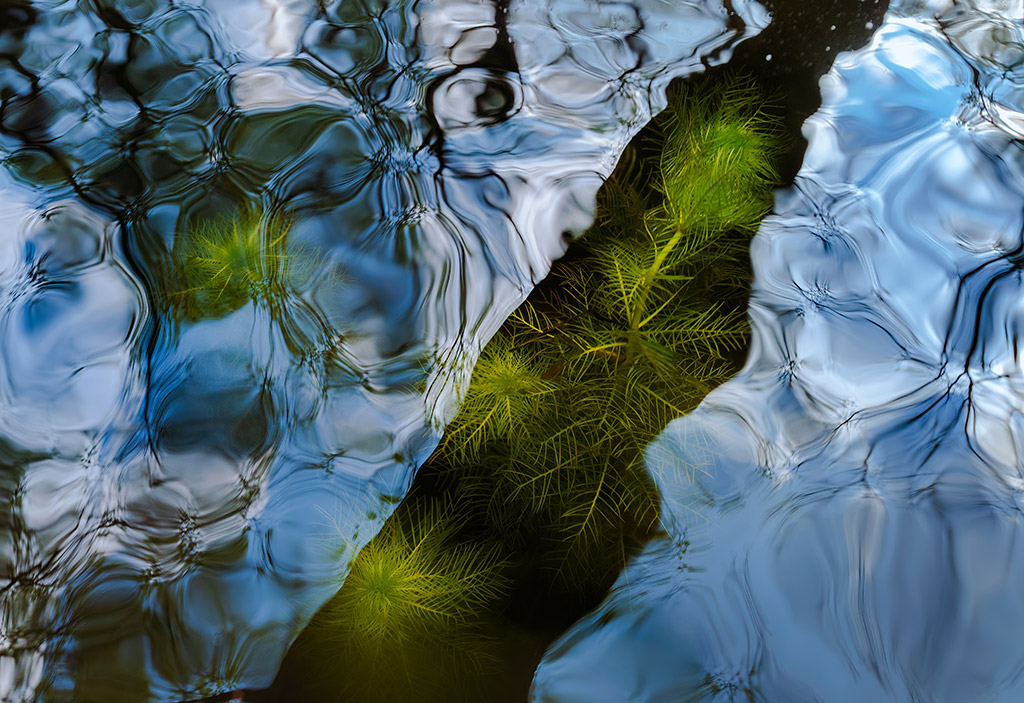
Camera: Nikon Z6 Lens: Nikkor AF-S 16-35mm f/4 ED ISO: 1250 Aperture: f/9 Shutter speed: 1/320sec Accessories: None. © Csaba Daróczi | cupoty.com
Category: Intimate Landscape
Nationality: Hungarian
Occupation: Photographer
Further information: www.daroczicsaba.hu, Instagram: @daroczics
‘In the first days of May, I always return to a small canal near Izsák, Hungary, where the water violet (Hottonia palustris) blooms in huge numbers. Unfortunately, flowering was delayed this year and only the leaves were still underwater. I was about to go home when I saw a tree had fallen over the canal and under its reflection the plants were clearly visible. I found it a very exciting subject and played with it for a while.’
Csaba’s top close-up photography tips:
- Often picture opportunities present themselves when you’re about to pack up and go home. Stay a little longer and see what arises.
- Find a location with potential and visit it repeatedly in all weathers.
- Play close attention to your surroundings – it takes good observational skills to spot a picture like this.
Winner: Plants
Reflexion by Ria Bloemendaal

Camera: Canon EOS 6D Mk II Lens: Canon 70-200mm f/2.8 L IS II USM ISO: 100 Aperture: f/2.8 Shutter speed: 1/400sec Accessories: Tripod Post processing: Basic adjustments in Lightroom, cropped and flipped. © Ria Bloemendaal | cupoty.com
Category: Plants
Nationality: Dutch
Occupation: Retired remedial educationalist
Further information: Website: www.riabloemendaal.nl, Instagram: @riabloemendaal33, Facebook: riabloemendaal
‘I spotted this reflection in the water at Trompenburg Botanical Gardens & Arboretum in Rotterdam, and it instantly inspired me to make an ‘impressionist painting’. I’ve always felt connected to nature, and I use photography to show who I am, what I feel and how I see the world. When I make pictures, I often become completely focused on the subject and can enter a flow state that causes me to forget everything that’s happening around me.’
Ria’s top close-up photography tips:
- Pay attention to reflections in the water – everything is constantly moving, and new compositions will present themselves every few seconds.
- Attend workshops and read as much as you can about art and personal expression.
- Explore your immediate environment before heading further afield – many interesting pictures can be made on your doorstep.
Winner: Underwater
Dreamtime by Simon Theuma
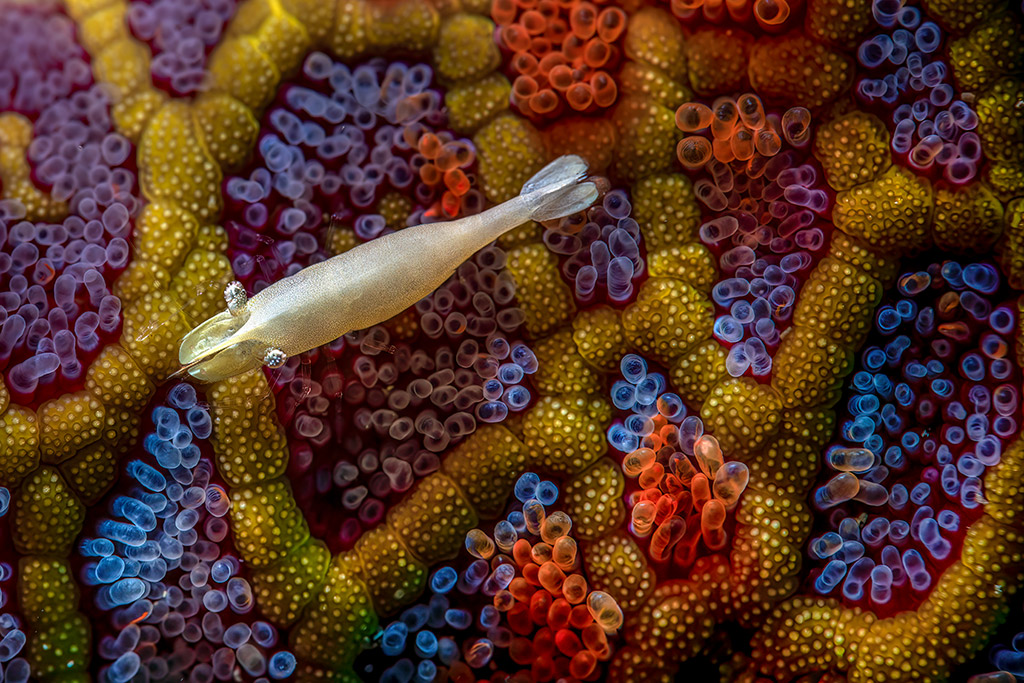
Camera: Nikon D850 Lens: Nikkor 85mm f/2.8G ISO: 64 Aperture: f/14 Shutter speed: 1/200sec
Accessories: Sea & Sea Housing, YS-250 Pro Strobes, INON UCL67 +15 Wet Dioptre (underwater close-up lens), snoot. © Simon Theuma | cupoty.com
Category: Underwater
Nationality: Australian
Occupation: Education trainer
Further information: Website: www.simontheuma.com.au, Instagram: @simontheumaphotography, Facebook: Simon Theuma
‘Like an intricate tapestry of the marine ecosystem, this image captures the relationship between a commensal shrimp and a mosaic sea star. Dreamtime Aboriginal art reminds us of the delicate balance that exists in the grand tapestry of our natural world – this ancient wisdom serves as an important reminder to preserve what we have. To capture this image, I needed to use a snooted strobe, which was set at an acute angle to the subject. This set up accentuated the depth and beautiful texture of the two organisms. Additionally, I enhanced magnification by using a +15 wet lens dioptre.’
Simon’s top close-up photography tips:
- Start taking pictures from a distance so you don’t disturb the subject, then move gradually closer.
- Use light creatively to enhance textures.
- Mastering buoyancy skills is not only crucial for the safety of the diver but also plays a crucial role in preserving marine life and capturing sharp and clear images underwater.
Winner: Young Close-up Photographer of the Year 5
Small Wonders by Carlos Pérez Naval

Camera: Nikon D500 Lens: Nikkor 105mm ISO: 1250 Aperture: f/18 Shutter speed: 1/4sec Accessories: Tripod. © Carlos Pérez Naval | cupoty.com
Category: Young Close-up Photographer of the Year
Nationality: Spanish
Age: 17
Further information: Instagram: @cpereznaval
‘In the wall of some houses in Calamocha – the village in Spain where I live – it’s possible to find pyrolusites. These magnesium minerals create stunning formations, which look just like petrified trees, but they are so small that they’re tricky to spot. One day, I was lucky enough to find a Moorish gecko (Tarentola mauritanica) very close to the pyrolusite’s wall, so I tried to make the most of the encounter. I wanted to capture a gecko in the ‘petrified forest’ for a long time, but they only recently appeared in my village (probably carried in fruit baskets from hotter areas). Due to climate change they can now survive here.’
Carlos’ top close-up photography tips:
- Beauty is all around us but sometimes we have to really pay attention to find it.
- Be patient. You might have to wait a long time for a shot you’ve previsualised to come together.
- Experiment with composition. Break some of the ‘rules’ of photography once in a while!
2nd Place: Fungi & Slime Moulds
Autumn Emergence by Jay Birmingham
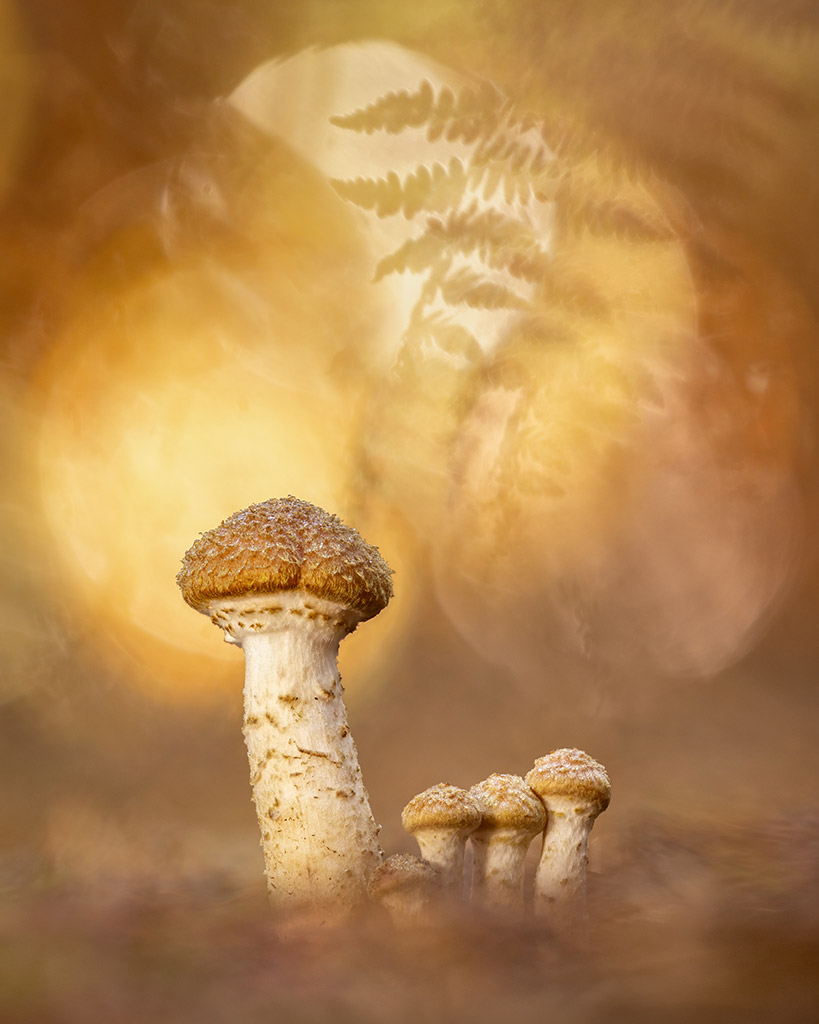
Camera: Canon EOS R5 Lens: Sigma 180mm macro f/2.8 ISO: 500 Aperture: f/3.2 Shutter speed: 1/60sec Accessories: Beanbag and small light to fill the shadows at the front. Post processing: Focus stacked using Helicon Focus. Basic adjustments in Lightroom. © Jay Birmingham | cupoty.com
Category: Fungi & Slime Moulds
Nationality: British
Occupation: Teacher
Further information: Website: www.jaybirmingham.com, Instagram: @jaybirminghamphotography, Facebook: Jaybirminghamphotography, Twitter: @Jay_B_Photos
‘I came across some honey fungi in my local woodland, just as the sun was rising and lighting up the woods with golden hues. The bonus was the bracken behind, which gave the picture a wonderfully warm autumnal feel. I used a wide aperture to isolate the fungi and maximise the bokeh in the background.’
Jay’s top close-up photography tips:
- Use a wide aperture and a long lens to capture some wonderful bokeh.
- Focus stack to keep as much of the subject in focus as possible, whilst still being able to use a wide aperture.
- Go out early or just before sunset. Although fungi will be there all day, the light at these times is at its best.
3rd Place: Animals
Natural Architecture by David Joseph

Camera: Olympus OM-D E-M5 II Lens: Olympus M.Zuiko 60mm f/2.8 macro ISO: 200 Aperture: f/11 Shutter speed: 1/1250sec © David Joseph | cupoty.com
Category: Animals
Nationality: Nigerian
Occupation: Student
Further information: Further information: Instagram: @abcdee_david
‘It was probably my first experience with a sac spider, photography wise. The spider had become alert, as my diffuser had touched some nearby grass. I was mad at myself for not taking the shot before the spider was aware of my presence. It was only my second month with a camera, so I was still learning. The few seconds I had with it (after it became alert) made my heart beat fast – I would have been so annoyed if I’d missed the shot.’
David’s top close-up photography tips:
- Think first, shoot second. It’s important to pre-visualise the end result as you might not have long with the animal.
- Approach slowly. Spiders are very alert, and you don’t want to disturb one and miss the picture.
- You may only get one shot. Make it count; focus accurately.
Finalist: Animals
The Banquet by Juan Jesus Gonzalez Ahumada

Camera: Canon EOS R6 Lens: Canon EF 100mm f/2.8L Macro IS USM ISO: 320 Aperture: f/5.6 Shutter speed: 1/80sec Accessories: Ring flash. © Juan Jesus Gonzalez Ahumada | cupoty.com
Category: Animals
Nationality: Spanish
Age: 17
Further information: Instagram: @jjgahumada
‘This image shows the harsh reality of nature, how the death of one can mean life for others. This young sparrow probably fell into the pond on its first flight and drowned, but its death will not be wasted as the tadpoles feed on this unusual offering that fell from the sky. I had to wait patiently for the bird to spin slowly into the right position and reveal its lifeless eye, which gives the picture drama and meaning. It was the middle of summer in Andalusia, and it was a battle to control the unforgiving and difficult light.’
Juan Jesus’s top close-up photography tips:
- Never touch the water or you’ll frighten the wildlife and disrupt the scene.
- Cultivate the mindset of always being ready for a photographic opportunity.
- If you find something as unusual as this it’s easy to forget composition and fire away. Spend a few moments making sure the framing is right.
Related content:
Portrait of Britain 2024 winners announced
Stunning images and video honoured in ViewSonic awards
Best photography competitions to enter this year!
Follow AP on Facebook, Twitter, Instagram, YouTube and TikTok.

